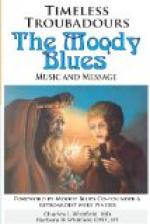Arabic learning known to the West. He was a poet
and the importance of the Sicilian school consists
in the [106] fact that while the subject matter
of their songs was lifted from troubadour poetry,
the language which they used belonged to the Italian
peninsula. The dialect of these
provenzaleggianti
was not pure Sicilian but was probably a literary
language containing elements drawn from other dialects,
as happened long before in the case of the troubadours
themselves. The best known representatives of
this school, Pier delle Vigne, Jacopo da Lentini and
Guido delle Colonne are familiar to students of Dante.
After their time no one questioned the fact that lyric
poetry written in Italian was a possible achievement.
The influence of the Sicilian school extended to Central
Italy and Tuscany; Dante tells us that all Italian
poetry preceding his own age was known as Sicilian.
The early Tuscan poets were, mediately or immediately,
strongly influenced by Provencal. The first examples
of the sonnet, by Dante da Majano, were written in
that language. But such poetry was little more
than a rhetorical exercise. It was the revival
of learning and the Universities, in particular that
of Bologna, which inspired the
dolce stil nuovo,
of which the first exponent was Guido Giunicelli.
Love was now treated from a philosophical point of
view: hitherto, the Provencal school had maintained
the thesis that “sight is delight,” that
love originated from seeing and pleasing, penetrated
to the heart and [107] occupied the thoughts, after
passing through the eyes. So Aimeric de Pegulhan.
Perque tuit li fin aman
Sapchan qu’amors es fina bevolenza
Que nais del cor e dels huelh, ses duptar.
“Wherefore let all pure lovers know that love
is pure unselfishness which is born undoubtedly from
the heart and from the eyes,” a sentiment thus
repeated by Guido delle Colonne of the Sicilian school.
Dal cor si move un spirito in vedere
D’in ochi’n ochi, di femina
e d’omo
Per lo quel si concria uno piacere.
The philosophical school entirely transformed this
conception. Love seeks the noble heart by affinity,
as the bird seeks the tree: the noble heart cannot
but love, and love inflames and purifies its nobility,
as the power of the Deity is transmitted to the heavenly
beings. When this idea had been once evolved,
Provencal poetry could no longer be a moving force;
it was studied but was not imitated. Its influence
had lasted some 150 years, and as far as Italy is
concerned it was Arabic learning, Aristotle and Thomas
Aquinas who slew the troubadours more certainly than
Simon de Montfort and his crusaders. The day of
superficial [108] prettiness and of the cult
of form had passed; love conjoined with learning,
a desire to pierce to the roots of things, a greater
depth of thought and earnestness were the characteristics
of the new school.




